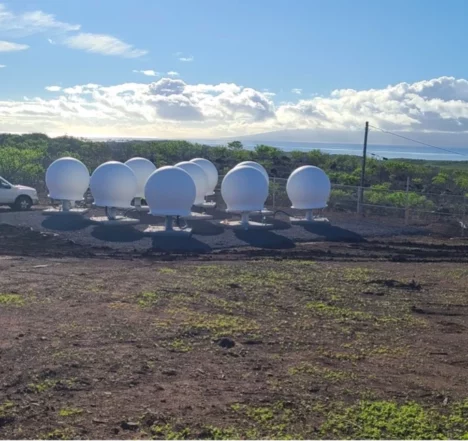Questions Remain for Hawaii Pacific Teleport Project
Nine satellite earth station antennas representing the Hawaii Pacific Teleport (HPT) project have been installed in Ho’olehua at the Goodfellow Brothers’ quarry. These white orbs are currently the subject of inquiry as they face a decision by the Molokai Planning Commission on Jan. 24.
The goal of the project is to expand Wi-Fi and cell phone coverage across Molokai and the surrounding ocean without the need for fiber cables, explained Haloa Dudoit, director of community outreach for the project.
“The antennas will allow residents to access reliable internet and Wi-Fi calling even in remote areas of Molokai and on the ocean,” said Dudoit.
Part of the reason Molokai was chosen as a location for the antennas is due to its low frequency interference, according to the project website.
Mayor Richard Bissen approved turning on the satellite earth station antennas following the Lahaina fires to support internet connectivity for emergency responders. The mayor’s approval will last until the Molokai Planning Commission rules on the project.
“The project team mistakenly believed that the equipment could be put in place while they applied for a permit as long as the equipment was not activated,” explains the HPT website.
Some Molokai residents have voiced concerns and confusion regarding the project.
“Hardly anyone on the island knew these things were there. On Molokai, that’s hard to do,” explained Walter Ritte, an activist who opposes the project. “We don’t know what the benefits are to the community.”
One proposed benefit of the project is better cell phone coverage.
“Currently, T-Mobile customers will benefit from direct to cell services. Other cell phone providers that sign up for support will also benefit from the deployment. In addition, any customer of the service will have broadband and Wi-Fi calling,” explained Dudoit.
These improvements in reception could be useful for emergency responders, among others, in areas like Halawa Valley.
Ritte, however, explained that not having internet was a major feature of special places like Halawa.
“We go to Halawa to get away,” said Ritte. “We don’t want [internet], it’s not a big deal. That’s not why you go to Halawa.”
And while the project proposes to deliver faster, more reliable, more accessible internet service via satellite to remote areas, Hawaii Telecom recently announced that 95 percent of Molokai residents are now eligible for their fiber-optic internet services. The influx of internet upgrades is largely the result of different federal and state initiatives aimed at improving internet access equity. The HPT falls under the Federal Broadband Act, according to Dudoit.
Now, the HPT is waiting to hear about their application for an after-the-fact permit from the Molokai Planning Commission.
Dudoit was hopeful that the 2600-square-foot project, which he explained “will not require additional infrastructure or impact historic or cultural properties or protected species,” will be approved by the planning commission on Jan. 24.
Molokai residents can attend the planning commission’s public meeting to provide feedback on the project.
Read more about the HPT on their website, hawaiipacificteleportmolokai.com.












Don't have a Molokai Dispatch ID?
Sign up is easy. Sign up now
You must login to post a comment.
Lost Password